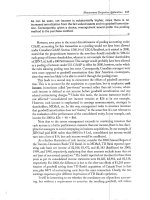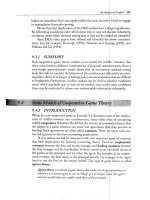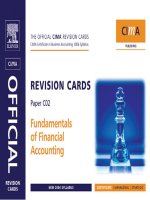Financial accounting 10th by harmin ch04
Bạn đang xem bản rút gọn của tài liệu. Xem và tải ngay bản đầy đủ của tài liệu tại đây (5.58 MB, 76 trang )
Prepared by
Coby Harmon
University of California, Santa Barbara
Westmont College
4-1
4
Completing the
Accounting Cycle
Learning Objectives
4-2
1
Prepare a worksheet.
2
Prepare closing entries and a post-closing trial balance.
3
Explain the steps in the accounting cycle and how to
prepare correcting entries.
4
Identify the sections of a classified balance sheet.
LEARNING
OBJECTIVE
1
Prepare a worksheet.
Worksheet
4-3
Multiple-column form used in preparing financial
statements.
Not a permanent accounting record.
May be a computerized worksheet using an electronic
spreadsheet program such as Excel.
Prepared using a five step process.
Use of worksheet is optional.
LO 1
Steps in Preparing a Worksheet
Illustration 4-1
4-4
Steps in Preparing a Worksheet
Illustration 4-2
1. PREPARE A TRIAL BALANCE ON THE WORKSHEET
Trial balance amounts come
directly from ledger accounts.
Include all accounts
with balances.
4-5
LO 1
Steps in Preparing a Worksheet
Illustration 3-23
General journal
showing adjusting
entries
Adjusting
Journal
Entries
(Chapter 3)
4-6
LO 1
Steps in Preparing a Worksheet
Illustration 4-2
2. ENTER THE ADJUSTMENTS IN THE ADJUSTMENTS COLUMNS
(a)
(b)
(d)
(d)
(e)
(g)
(a)
(b)
Adjustments Key:
(a) Supplies Used.
(b) Insurance Expired.
(c) Depreciation Expensed.
(d) Service Revenue Recognized.
(e) Service Revenue Accrued.
(f) Interest Accrued.
(g) Salaries Accrued.
(c)
(c)
(e)
(f)
(f)
(g)
4-7
Add additional accounts as needed.
Enter adjustment amounts, total
adjustments columns,
and check for equality.
LO 1
Steps in Preparing a Worksheet
Illustration 4-2
3. COMPLETE THE ADJUSTED TRIAL BALANCE COLUMNS
(a)
(b)
(d)
(d)
(e)
(g)
(a)
(b)
(c)
(c)
(e)
(f)
(f)
(g)
4-8
Total the adjusted trial balance
columns and check for equality.
LO 1
Steps in Preparing a Worksheet
Illustration 4-2
4. EXTEND AMOUNTS TO FINANCIAL STATEMENT COLUMNS
(a)
(b)
(d)
(d)
(e)
(g)
(a)
(b)
(c)
(c)
(e)
(f)
(f)
(g)
4-9
Extend adjusted trial balance amounts to
appropriate financial statement columns.
LO 1
Steps in Preparing a Worksheet
Illustration 4-2
5. TOTAL COLUMNS, COMPUTE NET INCOME (LOSS)
(a)
(b)
(d)
(d)
(e)
(g)
(a)
(b)
(c)
(c)
(e)
(f)
(f)
(g)
4-10
Compute Net Income or Net Loss.
LO 1
Steps in Preparing a Worksheet
Question
Net income is shown on a worksheet in the:
a. income statement debit column only.
b. balance sheet debit column only.
c. income statement credit column and balance sheet
debit column.
d. income statement debit column and balance sheet
credit column.
4-11
LO 1
Preparing Financial Statements from
a Worksheet
4-12
Income statement is prepared from the income statement
columns.
Balance sheet and retained earnings statement are
prepared from the balance sheet columns.
Companies can prepare financial statements before they
journalize and post adjusting entries.
LO 1
Preparing Statements from a Worksheet
Illustration 4-3
Financial statements
from a worksheet
4-13
LO 1
Preparing Statements from a Worksheet
Illustration 4-3
Financial statements
from a worksheet
4-14
LO 1
Illustration 4-3
4-15
LO 1
Preparing Adjusting Entries from a
Worksheet
4-16
Adjusting entries are prepared from the adjustments
columns of the worksheet.
Journalizing and posting of adjusting entries follows the
preparation of financial statements when a worksheet is
used.
LO 1
DO IT! 1
Worksheet
Susan Elbe is preparing a worksheet. Explain to Susan how she
should extend the following adjusted trial balance accounts to the
financial statement columns of the worksheet.
Cash
Balance sheet (debit column)
Accumulated Depreciation
Balance Sheet (credit column)
Accounts Payable
Balance Sheet (credit column)
Dividends
Balance sheet (debit column)
Service Revenue
Income statement (credit
column)
Income statement (debit column)
Salaries and Wages Expense
4-17
LO 1
LEARNING
OBJECTIVE
2
Prepare closing entries and a postclosing trial balance.
At the end of the accounting period, the company makes
the accounts ready for the next period.
Illustration 4-4
Temporary versus permanent accounts
4-18
LO 2
Preparing Closing Entries
Closing entries formally recognize in the ledger the transfer of
net income (or net loss) and
Dividends
to Retained Earnings.
Companies generally journalize and post closing entries only at
the end of the annual accounting period.
Closing entries produce a zero balance in each temporary
account.
4-19
LO 2
Preparing Closing Entries
Illustration 4-5
Diagram of closing
process—corporation
Retained earnings is a
permanent account. All
other accounts are
temporary accounts.
4-20
LO 2
Preparing Closing Entries
CLOSING
ENTRIES
ILLUSTRATED
Illustration 4-6
Closing entries
journalized
4-21
Posting
Closing
Entries
Illustration 4-7
4-22
LO 2
4-23
LO 2
Preparing a Post-Closing Trial Balance
Purpose is to prove the equality of the permanent account balances
carried forward into the next accounting period.
Illustration 4-8
Post-closing trial balance
Illustration 4-8
4-24
LO 2
DO IT! 2
Closing Entries
Hancock Company has the following balances in selected accounts of its
adjusted trial balance.
Accounts Payable
$27,000
Service Revenue
98,000
Retained Earnings
42,000
Rent Expense
22,000
Accounts Receivable
38,000
7,000
Salaries and Wages
Expense
51,000
Supplies Expense
Dividends
$15,000
Prepare the closing entries at December 31.
4-25
Service Revenue
Income Summary
98,000
Income Summary
Salaries and Wages Expense
Rent Expense
Supplies Expense
80,000
98,000
51,000
22,000
7,000
LO 2









